Carbon Emissions in Transportation: A Synthesis Framework
Abstract
1. Introduction
2. Theoretical Background
2.1. Sustainability Transition Landscape
2.2. Multi-Level Theory of Socio-Technical Transitions
- Niches: the small protected spaces where innovation takes place;
- Socio-technical regimes: the areas of established practices, technologies, and regulations;
- Socio-technical landscape: the wider external context.
2.3. Basic Elements of the Theory of Contingency in Strategy and Operations Management Research
3. Methodology
Step-by-Step Approach for the Systematic Literature Review
4. Results
4.1. Overview of Studies Selected for Tertiary Review
4.2. Typology of Carbon Emissions Reduction in Transportation
| Dimensions | Categories | Papers |
|---|---|---|
| Enablers and barriers | Technological innovations | [44,45,47,49,50,51,52,54,56,59,61,62,63,66] |
| Operational measures | [44,45,49,52,54,59,62] | |
| Regulatory and economic measures | [45,52,55,58,59,61,67,68] | |
| Urban form and human behaviour | [46,51,53,61,63] | |
| Strategy and stakeholder pressure | [45,54] | |
| Benefits and disadvantages | Climate change and other emissions | [43,47] |
| Health | [43,47] | |
| Competitive advantage | [45] | |
| Cost impact | [45,68] | |
| Metrics | Measurement and performance indicators | [43,45,49,57,60] |
| Emissions modelling and inputs | [48,59,64,65,66] | |
| Life-cycle assessment | [45,49,56,60,61,62] |
4.3. Enablers and Barriers
4.3.1. Technological Innovations
4.3.2. Operational Measures
4.3.3. Regulatory and Economic Measures
4.3.4. Urban Form and Human Behaviour
4.3.5. Strategy and Stakeholder Pressure
4.4. Benefits and Disadvantages
4.5. Metrics
4.6. Synthesis Framework
5. Discussions
6. Conclusions
6.1. Practical Implications
6.2. Study Limitations
6.3. Future Research
Author Contributions
Funding
Institutional Review Board Statement
Informed Consent Statement
Data Availability Statement
Conflicts of Interest
Appendix A
| Literature Reviews | No. of Studies | Review Methodology | Transportation Modes | Sustainability Dimensions |
|---|---|---|---|---|
| Smit et al. [64] | 50 | Meta-analysis | Road | Environmental 3 |
| Eijgelaar [55] 2 | 80 | Literature review | Air—Tourism | Environmental 3 |
| Li [61] 2 | 98 | Critical review | Multimodal—Urban | Environmental, social, and financial 3 |
| Miola and Ciuffo [65] 2 | 49 | Meta-analysis | Maritime | Environmental and social 3 |
| Hawkins et al. [56] | 51 | Literature review | Multimodal—Hybrid and electric vehicles | Environmental 3 |
| Franco et al. [57] 2 | 190 | Literature review | Road | Environmental 3 |
| Faris et al. [66] 2 | 80 | State-of-the-art review | Road—Intelligent Systems | Environmental 3 |
| Kwan and Hashim [43] | 9 | Systematic review | Multimodal—Mass public | Environmental and social 3 |
| Bouman et al. [44] | 150 | Systematic review | Maritime | Environmental 3 |
| Garcia and Freire [62] | 69 | Critical review | Road—Light-duty fleet vehicles | Environmental |
| Herold and Lee [45] | 66 | Systematic literature review | Multimodal—Logistics and freight | Environmental |
| Czepkiewicz et al. [46] | 27 | Systematic review | Multimodal—Long-distance leisure travel | Environmental 3 |
| Requia et al. [47] | 65 | Systematic review | Road—Electric mobility | Environmental and social |
| Salvucci et al. [63] | 8 | Critical review | Multimodal—European Nordic countries | Environmental 3 |
| Arioli et al. [48] | 40 | Systematic review | Multimodal—Urban | Environmental 3 |
| Lagouvardou et al. [58] 2 | 78 | Literature review | Maritime | Environmental |
| Meyer [49] 1 | 715 | Systematic quantitative review | Road freight | Environmental |
| O’Mahony [67] 2 | 33 | State-of-the-art review | Unspecified—Carbon taxes | Environmental and financial |
| Oguntona [59] | 11 | Literature review | Air | Environmental 3 |
| Pilz et al. [50] | 18 | Systematic review | Multimodal—Transport in manufacturing industry | Environmental |
| Schinas and Bergmann [68] | 102 | Integrative literature review | Multimodal—Aviation and maritime | Environmental and financial 3 |
| Wimbadi et al. [51] | 41 | Systematic literature review | Multimodal—Public transport | Environmental 3 |
| Alamoush et al. [52] | 112 | Systematic literature review | Multimodal—Marine ports (including land transport) | Environmental 3 |
| Hu and Creutzig [53] | 687 | Systematic review | Multimodal—Shared mobility | Environmental, social, and financial |
| Miklautsch and Woschank [54] | 81 | Systematic literature review | Multimodal—Freight | Environmental 3 |
| Noussan et al. [60] 2 | 73 | Literature review | Multimodal—Passenger transport | Environmental 3 |
| Hoang et al. [69] | 45 | Systematic Literature Review | Road | Environmental |
| de Abreu et al. [9] 1 | 280 | Systematic Literature Review | Road | Environmental |
| Camargo-Diaz et al. [71] | 130 | Literature Review | Maritime | Environmental |
| Vidovic et al. [70] | 123 | Literature Review | Maritime | Environmental |
References
- Wang, F.; Harindintwali, J.D.; Yuan, Z.; Wang, M.; Wang, F.; Li, S.; Yin, Z.; Huang, L.; Fu, Y.; Li, L.; et al. Technologies and Perspectives for Achieving Carbon Neutrality. Innovation 2021, 2, 100180. [Google Scholar] [CrossRef] [PubMed]
- Pathak, M.; Slade, R.; Shukla, J.; Skea, R.; Pichs-Madruga, D. Ürge-Vorsatz Technical Summary. In Climate Change 2022: Mitigation of Climate Change. Contribution of Working Group III to the Sixth Assessment Report of the Intergovernmental Panel on Climate Change; Shukla, P.R., Skea, J., Slade, R., Al Khoudarjie, A., van Diemen, R., McCollum, D., Pathak, S., Some, S., Vyas, P., Fradera, R., et al., Eds.; Cambridge University Press: Cambridge, UK, 2022. [Google Scholar]
- Jaramillo, P.; Kahn Ribeiro, S.; Newman, P.; Dhar, S.; Diemuodeke, T.; Kajino, T.; Lee, D.S.; Nugroho, S.B.; Ou, X.; Hammer Strømman, A.; et al. Transport. In IPCC, 2022: Climate Change 2022: Mitigation of Climate Change. Contribution of Working Group III to the Sixth Assessment Report of the Intergovernmental Panel on Climate Change; Shukla, P.R., Skea, J., Slaade, R., Al Khourdajie, A., van Diemen, R., McCollum, D., Pathak, M., Some, S., Vyas, P., Fradera, R., et al., Eds.; Cambridge University Press: Cambridge, UK; New York, NY, USA, 2022; ISBN 9789291691609. [Google Scholar]
- Wei, G.; Bi, M.; Liu, X.; Zhang, Z.; He, B.J. Investigating the Impact of Multi-Dimensional Urbanization and FDI on Carbon Emissions in the Belt and Road Initiative Region: Direct and Spillover Effects. J. Clean. Prod. 2023, 384, 135608. [Google Scholar] [CrossRef]
- Zhou, Y.; Yu, Y.; Wang, Y.; He, B.; Yang, L. Mode Substitution and Carbon Emission Impacts of Electric Bike Sharing Systems. Sustain. Cities Soc. 2023, 89, 104312. [Google Scholar] [CrossRef]
- Eisenack, K.; Stecker, R.; Reckien, D.; Hoffmann, E. Adaptation to Climate Change in the Transport Sector: A Review of Actions and Actors. Mitig. Adapt. Strat. Glob. Chang. 2012, 17, 451–469. [Google Scholar] [CrossRef]
- Geels, F.W. A Socio-Technical Analysis of Low-Carbon Transitions: Introducing the Multi-Level Perspective into Transport Studies. J. Transp. Geogr. 2012, 24, 471–482. [Google Scholar] [CrossRef]
- Schwanen, T.; Banister, D.; Anable, J. Scientific Research about Climate Change Mitigation in Transport: A Critical Review. Transp. Res. Part. A Policy Pract. 2011, 45, 993–1006. [Google Scholar] [CrossRef]
- de Abreu, V.H.S.; Santos, A.S.; Monteiro, T.G.M. Climate Change Impacts on the Road Transport Infrastructure: A Systematic Review on Adaptation Measures. Sustainability 2022, 14, 8864. [Google Scholar] [CrossRef]
- Geels, F.W. Socio-Technical Transitions to Sustainability: A Review of Criticisms and Elaborations of the Multi-Level Perspective. Curr. Opin. Environ. Sustain. 2019, 39, 187–201. [Google Scholar] [CrossRef]
- Donaldson, L. The Contingency Theory of Organizations: Core Paradigm and Theoretical Integration; SAGE Publications, Inc.: Thousand Oaks, CA, USA, 2014. [Google Scholar]
- Sousa, R.; Voss, C.A. Contingency Research in Operations Management Practices. J. Oper. Manag. 2008, 26, 697–713. [Google Scholar] [CrossRef]
- Geels, F.W. The Multi-Level Perspective on Sustainability Transitions: Responses to Seven Criticisms. Environ. Innov. Soc. Transit. 2011, 1, 24–40. [Google Scholar] [CrossRef]
- Geels, F.W. Technological Transitions and System Innovations: A Co-Evolutionary and Socio-Technical Analysis; Edward Elgar: Cheltenham, UK, 2005; ISBN 1845420098. [Google Scholar]
- Seuring, S.; Yawar, S.A.; Land, A.; Khalid, R.U.; Sauer, P.C. The Application of Theory in Literature Reviews—Illustrated with Examples from Supply Chain Management. Int. J. Oper. Prod. Manag. 2021, 41, 1–20. [Google Scholar] [CrossRef]
- van Soest, H.L.; den Elzen, M.G.J.; van Vuuren, D.P. Net-Zero Emission Targets for Major Emitting Countries Consistent with the Paris Agreement. Nat. Commun. 2021, 12, 2140. [Google Scholar] [CrossRef] [PubMed]
- Rogelj, J.; Den Elzen, M.; Höhne, N.; Fransen, T.; Fekete, H.; Winkler, H.; Schaeffer, R.; Sha, F.; Riahi, K.; Meinshausen, M. Paris Agreement Climate Proposals Need a Boost to Keep Warming Well below 2 °C. Nature 2016, 534, 631–639. [Google Scholar] [CrossRef] [PubMed]
- Meinshausen, M.; Lewis, J.; McGlade, C.; Gütschow, J.; Nicholls, Z.; Burdon, R.; Cozzi, L.; Hackmann, B. Realization of Paris Agreement Pledges May Limit Warming Just below 2 °C. Nature 2022, 604, 304–309. [Google Scholar] [CrossRef]
- United Nations. World Population Prospects 2022 Summary of Results; United Nations: New York, NY, USA, 2022. [Google Scholar]
- FAO. The State of Food and Agriculture; FAO: Rome, Italy, 2016. [Google Scholar]
- IEA—International Energy Agency. World Energy Outlook 2021; IEA: Paris, France, 2022. [Google Scholar]
- Ritchie, H.; Roser, M.; Rosado, P. CO2 and Greenhouse Gas Emissions. Our World in Data. 2020. Available online: https://ourworldindata.org/co2-and-greenhouse-gas-emissions (accessed on 29 January 2023).
- IEA—International Energy Agency. CO2 Emissions in 2022; IEA: Paris, France, 2023. [Google Scholar]
- Humphreys, R.M.; Dumitrescu, A. Decarbonizing the Freight and Logistics Sector; World Bank: Washington, DC, USA, 2021. [Google Scholar]
- Anika, O.C.; Nnabuife, S.G.; Bello, A.; Okoroafor, E.R.; Kuang, B.; Villa, R. Prospects of Low and Zero-Carbon Renewable Fuels in 1.5-Degree Net Zero Emission Actualisation by 2050: A Critical Review. Carbon Capture Sci. Technol. 2022, 5, 100072. [Google Scholar] [CrossRef]
- Li, H.; Hao, Y.; Xie, C.; Han, Y.; Wang, Z.R. Emerging Technologies and Policies for Carbon–Neutral Transportation. Int. J. Transp. Sci. Technol. 2023, 12, 329–334. [Google Scholar] [CrossRef]
- Beck, C.; Kar, J.; Hal, S.; Olufon, D.; Bellone, D. The Big Choices for Oil and Gas in Navigating the Energy Transition; McKinsey Oil & Gas Practice: London, UK, 2021. [Google Scholar]
- Hellstern, T.; Henderson, K.; Kane, S.; Rogers, M. Innovating to Net Zero: An Executive’s Guide to Climate Technology; McKinsey & Company: New York, NY, USA, 2021. [Google Scholar]
- IEA—International Energy Agency. The Oil and Gas Industry in Energy Transitions; IEA: Paris, France, 2020. [Google Scholar]
- Bennett, N.; Lemoine, G.J. What a Difference a Word Makes: Understanding Threats to Performance in a VUCA World. Bus. Horiz. 2014, 57, 311–317. [Google Scholar] [CrossRef]
- IPIECA. Accelerating Action an SDG Roadmap for the Oil and Gas Sector; IPIECA: London, UK, 2021. [Google Scholar]
- Abraham-Dukuma, M.C.; Dioha, M.O.; Aholu, O.C.; Emodi, N.V.; Ogbumgbada, C.; Isah, A. A Marriage of Convenience or Necessity? Research and Policy Implications for Electrifying Upstream Petroleum Production Systems with Renewables. Energy Res. Soc. Sci. 2021, 80, 102226. [Google Scholar] [CrossRef]
- Drazin, R.; Van De Ven, A.H. Alternative Forms of Fit in Contingency Theory. Adm. Sci. Q. 1985, 30, 514–539. [Google Scholar] [CrossRef]
- Thomé, A.M.T.; Scavarda, L.F.; Scavarda, A.J. Conducting Systematic Literature Review in Operations Management. Prod. Plan. Control. 2016, 27, 408–420. [Google Scholar] [CrossRef]
- Grant, M.J.; Booth, A. A Typology of Reviews: An Analysis of 14 Review Types and Associated Methodologies. Health Inf. Libr. J. 2009, 26, 91–108. [Google Scholar] [CrossRef] [PubMed]
- Cooper, H. Research Synthesis and Meta-Analysis—A Step by Step Approach, 5th ed.; Sage Publications: London, UK, 2017. [Google Scholar]
- Mongeon, P.; Paul-Hus, A. The Journal Coverage of Web of Science and Scopus: A Comparative Analysis. Scientometrics 2016, 106, 213–228. [Google Scholar] [CrossRef]
- Verner, J.M.; Brereton, O.P.; Kitchenham, B.A.; Turner, M.; Niazi, M. Risks and Risk Mitigation in Global Software Development: A Tertiary Study. Inf. Softw. Technol. 2014, 56, 54–78. [Google Scholar] [CrossRef]
- Page, M.J.; McKenzie, J.E.; Bossuyt, P.M.; Boutron, I.; Hoffmann, T.C.; Mulrow, C.D.; Shamseer, L.; Tetzlaff, J.M.; Akl, E.A.; Brennan, S.E.; et al. The PRISMA 2020 Statement: An Updated Guideline for Reporting Systematic Reviews. Int. J. Surg. 2021, 88, 105906. [Google Scholar] [CrossRef] [PubMed]
- Hedges, L.V.; Cooper, H.M. Research Synthesis as a Scientific Process. In The Handbook of Research Synthesis and Meta-Analysis; Valentine, J., Hedges, L., Cooper, H., Eds.; Russell Sage Foundation: New York, NY, USA, 2009; p. 615. ISBN 9780871541635. [Google Scholar]
- Seuring, S.; Gold, S. Conducting Content-Analysis Based Literature Reviews in Supply Chain Management. Supply Chain. Manag. 2012, 17, 544–555. [Google Scholar] [CrossRef]
- Aria, M.; Cuccurullo, C. Bibliometrix: An R-Tool for Comprehensive Science Mapping Analysis. J. Inf. 2017, 11, 959–975. [Google Scholar] [CrossRef]
- Kwan, S.C.; Hashim, J.H. A Review on Co-Benefits of Mass Public Transportation in Climate Change Mitigation. Sustain. Cities Soc. 2016, 22, 11–18. [Google Scholar] [CrossRef]
- Bouman, E.A.; Lindstad, E.; Rialland, A.I.; Strømman, A.H. State-of-the-Art Technologies, Measures, and Potential for Reducing GHG Emissions from Shipping—A Review. Transp. Res. D Transp. Environ. 2017, 52, 408–421. [Google Scholar] [CrossRef]
- Herold, D.M.; Lee, K.H. Carbon Management in the Logistics and Transportation Sector: An Overview and New Research Directions. Carbon Manag. 2017, 8, 79–97. [Google Scholar] [CrossRef]
- Czepkiewicz, M.; Heinonen, J.; Ottelin, J. Why Do Urbanites Travel More Than Do Others? A Review of Associations between Urban Form and Long-Distance Leisure Travel. Environ. Res. Lett. 2018, 13, 073001. [Google Scholar] [CrossRef]
- Requia, W.J.; Mohamed, M.; Higgins, C.D.; Arain, A.; Ferguson, M. How Clean Are Electric Vehicles? Evidence-Based Review of the Effects of Electric Mobility on Air Pollutants, Greenhouse Gas Emissions and Human Health. Atmos. Environ. 2018, 185, 64–77. [Google Scholar] [CrossRef]
- Arioli, M.S.; D’Agosto, M.D.A.; Amaral, F.G.; Cybis, H.B.B. The Evolution of City-Scale GHG Emissions Inventory Methods: A Systematic Review. Environ. Impact Assess. Rev. 2020, 80, 106316. [Google Scholar] [CrossRef]
- Meyer, T. Decarbonizing Road Freight Transportation—A Bibliometric and Network Analysis. Transp. Res. D Transp. Environ. 2020, 89, 102619. [Google Scholar] [CrossRef]
- Pilz, T.L.; Nunes, B.; Corrêa Maceno, M.M.; Cleto, M.G.; Seleme, R. Systematic Analysis of Comparative Studies between Additive and Conventional Manufacturing Focusing on the Environmental Performance of Logistics Operations. Gest. Prod. 2020, 27, e5289. [Google Scholar] [CrossRef]
- Wimbadi, R.W.; Djalante, R.; Mori, A. Urban Experiments with Public Transport for Low Carbon Mobility Transitions in Cities: A Systematic Literature Review (1990–2020). Sustain. Cities Soc. 2021, 72, 103023. [Google Scholar] [CrossRef]
- Alamoush, A.S.; Ölçer, A.I.; Ballini, F. Port Greenhouse Gas Emission Reduction: Port and Public Authorities’ Implementation Schemes. Res. Transp. Bus. Manag. 2022, 43, 100708. [Google Scholar] [CrossRef]
- Hu, J.W.; Creutzig, F. A Systematic Review on Shared Mobility in China. Int. J. Sustain. Transp. 2022, 16, 374–389. [Google Scholar] [CrossRef]
- Miklautsch, P.; Woschank, M. A Framework of Measures to Mitigate Greenhouse Gas Emissions in Freight Transport: Systematic Literature Review from a Manufacturer’s Perspective. J. Clean. Prod. 2022, 366, 132883. [Google Scholar] [CrossRef]
- Eijgelaar, E. Voluntary Carbon Offsets a Solution for Reducing Tourism Emissions? Assessment of Communication Aspects and Mitigation Potential. EJTIR Issue 2011, 11, 281–296. [Google Scholar]
- Hawkins, T.R.; Gausen, O.M.; Strømman, A.H. Environmental Impacts of Hybrid and Electric Vehicles—A Review. Int. J. Life Cycle Assess. 2012, 17, 997–1014. [Google Scholar] [CrossRef]
- Franco, V.; Kousoulidou, M.; Muntean, M.; Ntziachristos, L.; Hausberger, S.; Dilara, P. Road Vehicle Emission Factors Development: A Review. Atmos. Environ. 2013, 70, 84–97. [Google Scholar] [CrossRef]
- Lagouvardou, S.; Psaraftis, H.N.; Zis, T. A Literature Survey on Market-Based Measures for the Decarbonization of Shipping. Sustainability 2020, 12, 3953. [Google Scholar] [CrossRef]
- Oguntona, O. Longer-Term Aircraft Fleet Modelling: Narrative Review of Tools and Measures for Mitigating Carbon Emissions from Aircraft Fleet. CEAS Aeronaut. J. 2020, 11, 13–31. [Google Scholar] [CrossRef]
- Noussan, M.; Campisi, E.; Jarre, M. Carbon Intensity of Passenger Transport Modes: A Review of Emission Factors, Their Variability and the Main Drivers. Sustainability 2022, 14, 10652. [Google Scholar] [CrossRef]
- Li, J. Decoupling Urban Transport from GHG Emissions in Indian Cities—A Critical Review and Perspectives. Energy Policy 2011, 39, 3503–3514. [Google Scholar] [CrossRef]
- Garcia, R.; Freire, F. A Review of Fleet-Based Life-Cycle Approaches Focusing on Energy and Environmental Impacts of Vehicles. Renew. Sustain. Energy Rev. 2017, 79, 935–945. [Google Scholar] [CrossRef]
- Salvucci, R.; Petrović, S.; Karlsson, K.; Wråke, M.; Uteng, T.P.; Balyk, O. Energy Scenario Analysis for the Nordic Transport Sector: A Critical Review. Energies 2019, 12, 2232. [Google Scholar] [CrossRef]
- Smit, R.; Ntziachristos, L.; Boulter, P. Validation of Road Vehicle and Traffic Emission Models—A Review and Meta-Analysis. Atmos. Environ. 2010, 44, 2943–2953. [Google Scholar] [CrossRef]
- Miola, A.; Ciuffo, B. Estimating Air Emissions from Ships: Meta-Analysis of Modelling Approaches and Available Data Sources. Atmos. Environ. 2011, 45, 2242–2251. [Google Scholar] [CrossRef]
- Faris, W.; Rakha, H.; Elmoselhy, S.A.M. Impact of Intelligent Transportation Systems on Vehicle Fuel Consumption and Emission Modeling: An Overview. Int. J. Mater. Manuf. 2014, 7, 129–146. [Google Scholar] [CrossRef]
- O’Mahony, T. State of the Art in Carbon Taxes: A Review of the Global Conclusions. Green Financ. 2020, 2, 409–423. [Google Scholar] [CrossRef]
- Schinas, O.; Bergmann, N. Emissions Trading in the Aviation and Maritime Sector: Findings from a Revised Taxonomy. Clean. Logist. Supply Chain. 2021, 1, 100003. [Google Scholar] [CrossRef]
- Hoang, T.T.; Pham, H.T.; Vu, H.M.T. From Intention to Actual Behavior to Adopt Battery Electric Vehicles: A Systematic Literature Review. Open. Transp. J. 2022, 16, e2208100. [Google Scholar] [CrossRef]
- Vidović, T.; Šimunović, J.; Radica, G.; Penga, Ž. Systematic Overview of Newly Available Technologies in the Green Maritime Sector. Energies 2023, 16, 641. [Google Scholar] [CrossRef]
- Camargo-Díaz, C.P.; Paipa-Sanabria, E.; Zapata-Cortes, J.A.; Aguirre-Restrepo, Y.; Quiñones-Bolaños, E.E. A Review of Economic Incentives to Promote Decarbonization Alternatives in Maritime and Inland Waterway Transport Modes. Sustainability 2022, 14, 14405. [Google Scholar] [CrossRef]
- Liu, S.; Wang, Y.; Liu, X.; Yang, L.; Zhang, Y.; He, J. How Does Future Climatic Uncertainty Affect Multi-Objective Building Energy Retrofit Decisions? Evidence from Residential Buildings in Subtropical Hong Kong. Sustain. Cities Soc. 2023, 92, 104482. [Google Scholar] [CrossRef]
- Chapman, L. Transport and Climate Change: A Review. J. Transp. Geogr. 2007, 15, 354–367. [Google Scholar] [CrossRef]
- Liu, X.; He, J.; Xiong, K.; Liu, S.; He, B.J. Identification of Factors Affecting Public Willingness to Pay for Heat Mitigation and Adaptation: Evidence from Guangzhou, China. Urban. Clim. 2023, 48, 101405. [Google Scholar] [CrossRef]
- Muñoz-Villamizar, A.; Velázquez-Martínez, J.C.; Haro, P.; Ferrer, A.; Mariño, R. The Environmental Impact of Fast Shipping Ecommerce in Inbound Logistics Operations: A Case Study in Mexico. J. Clean. Prod. 2021, 283, 125400. [Google Scholar] [CrossRef]
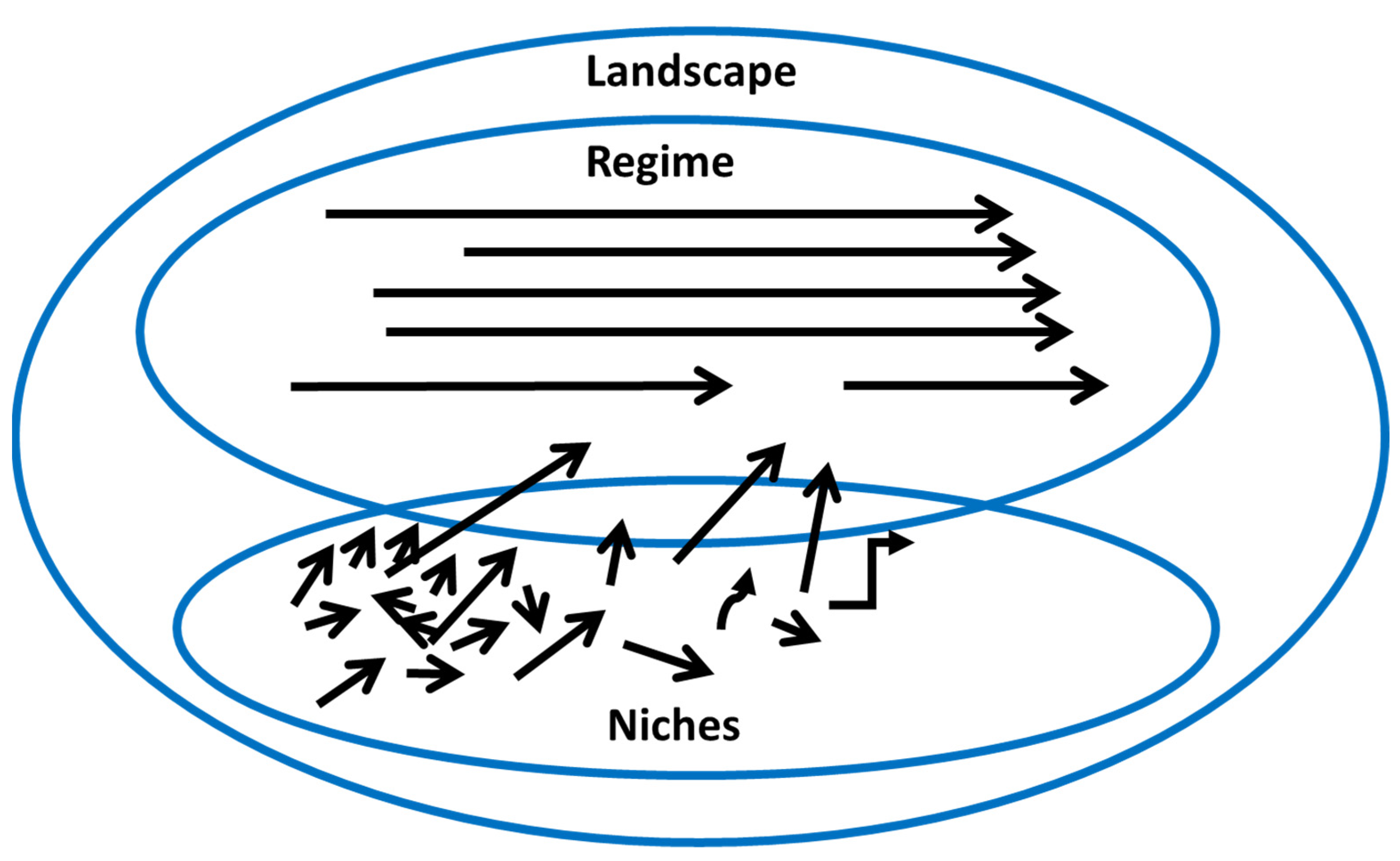
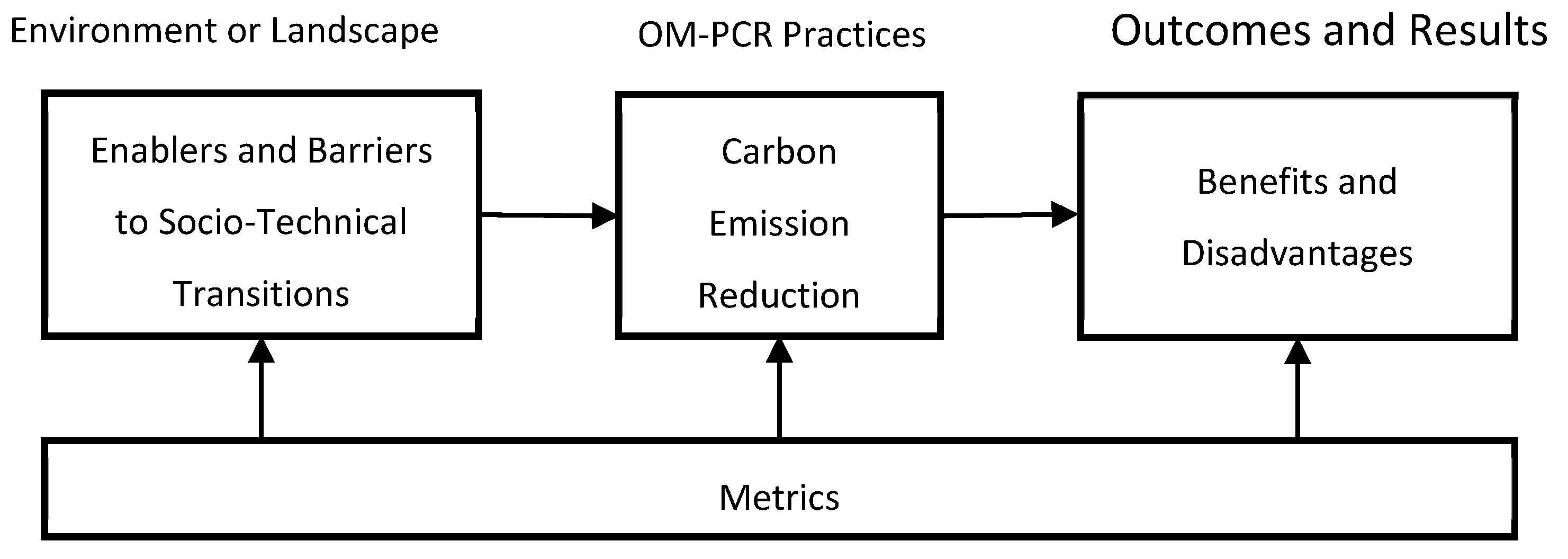
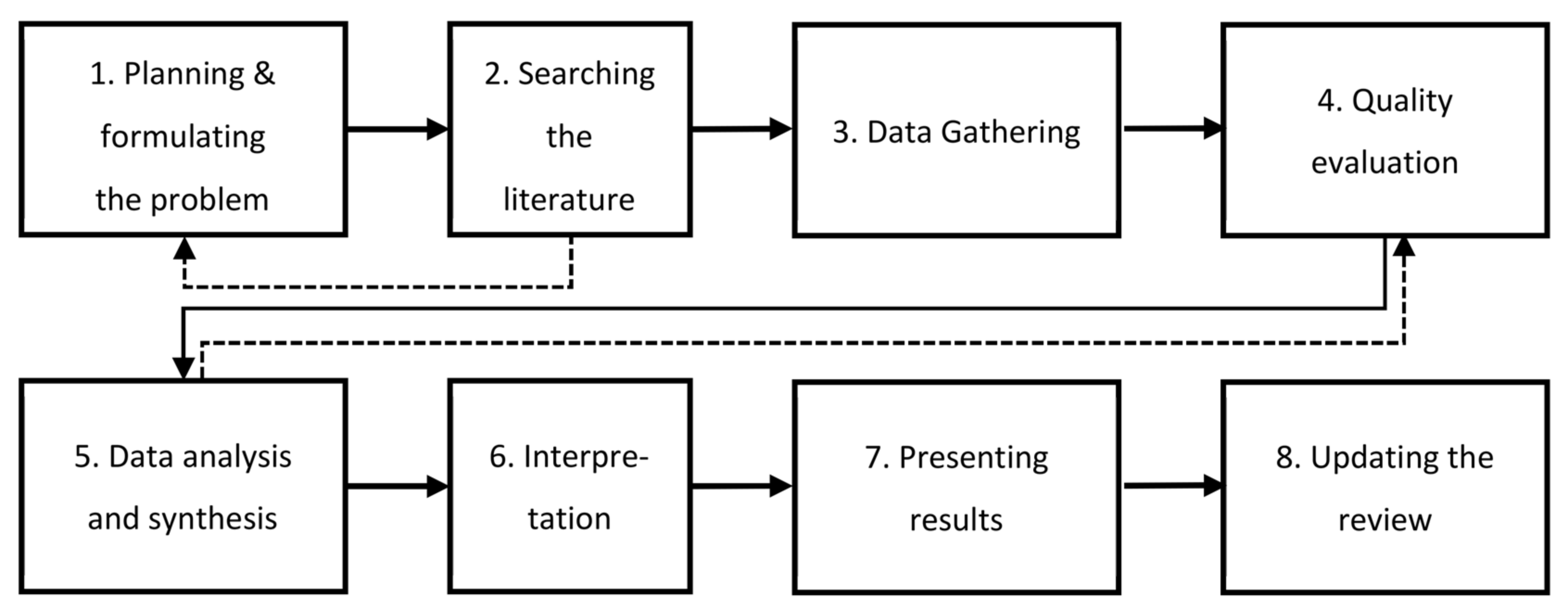
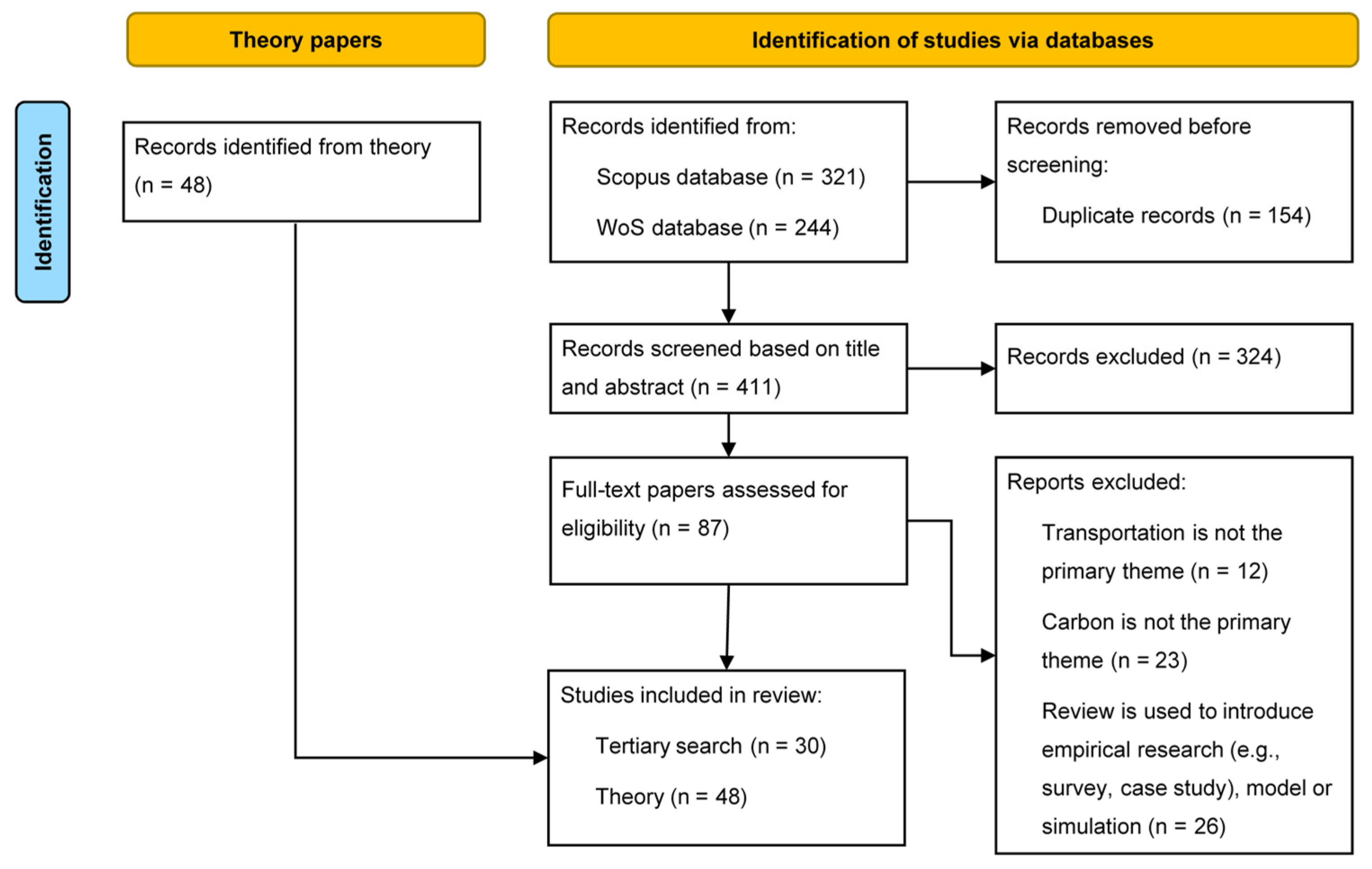
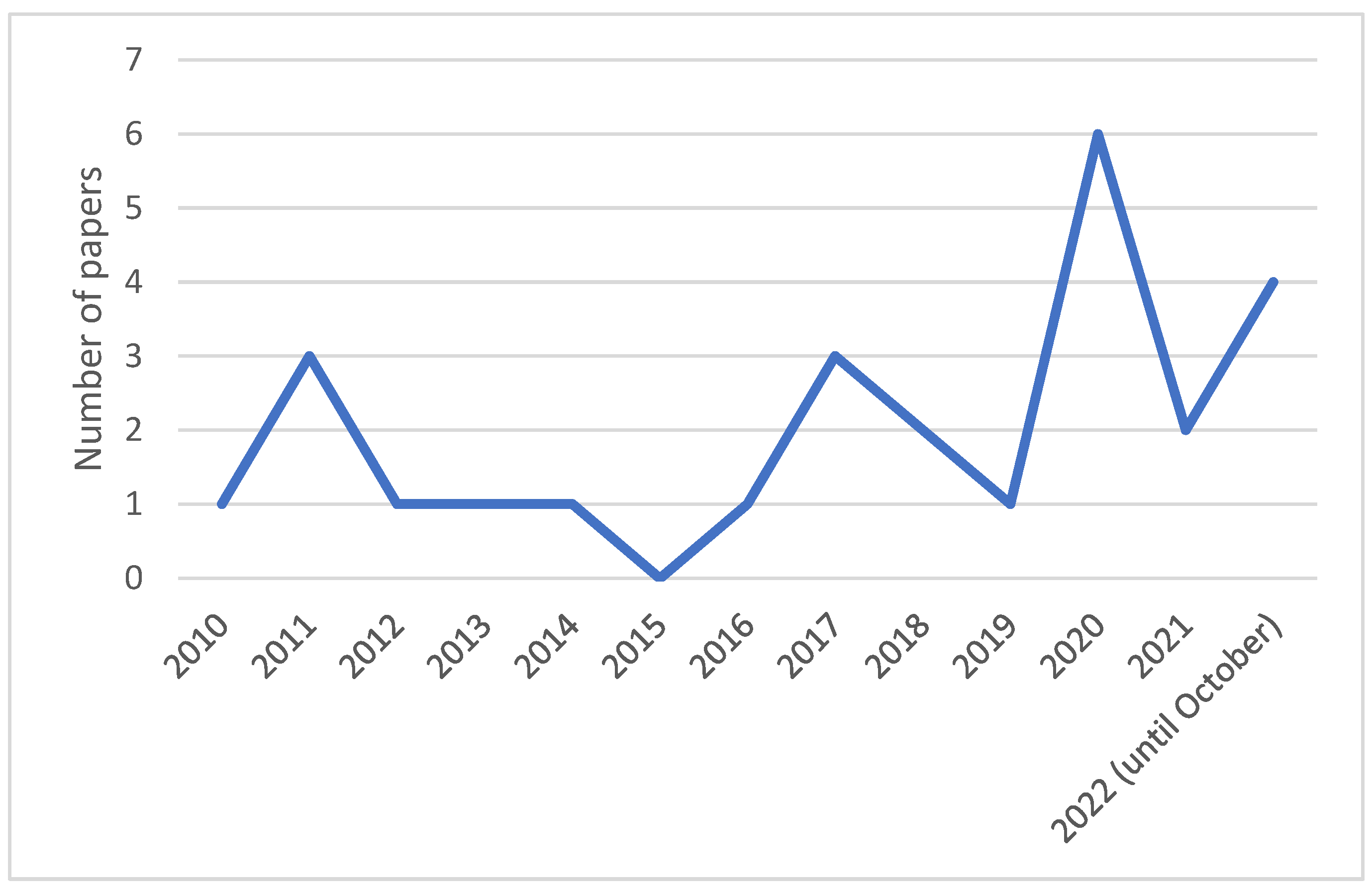
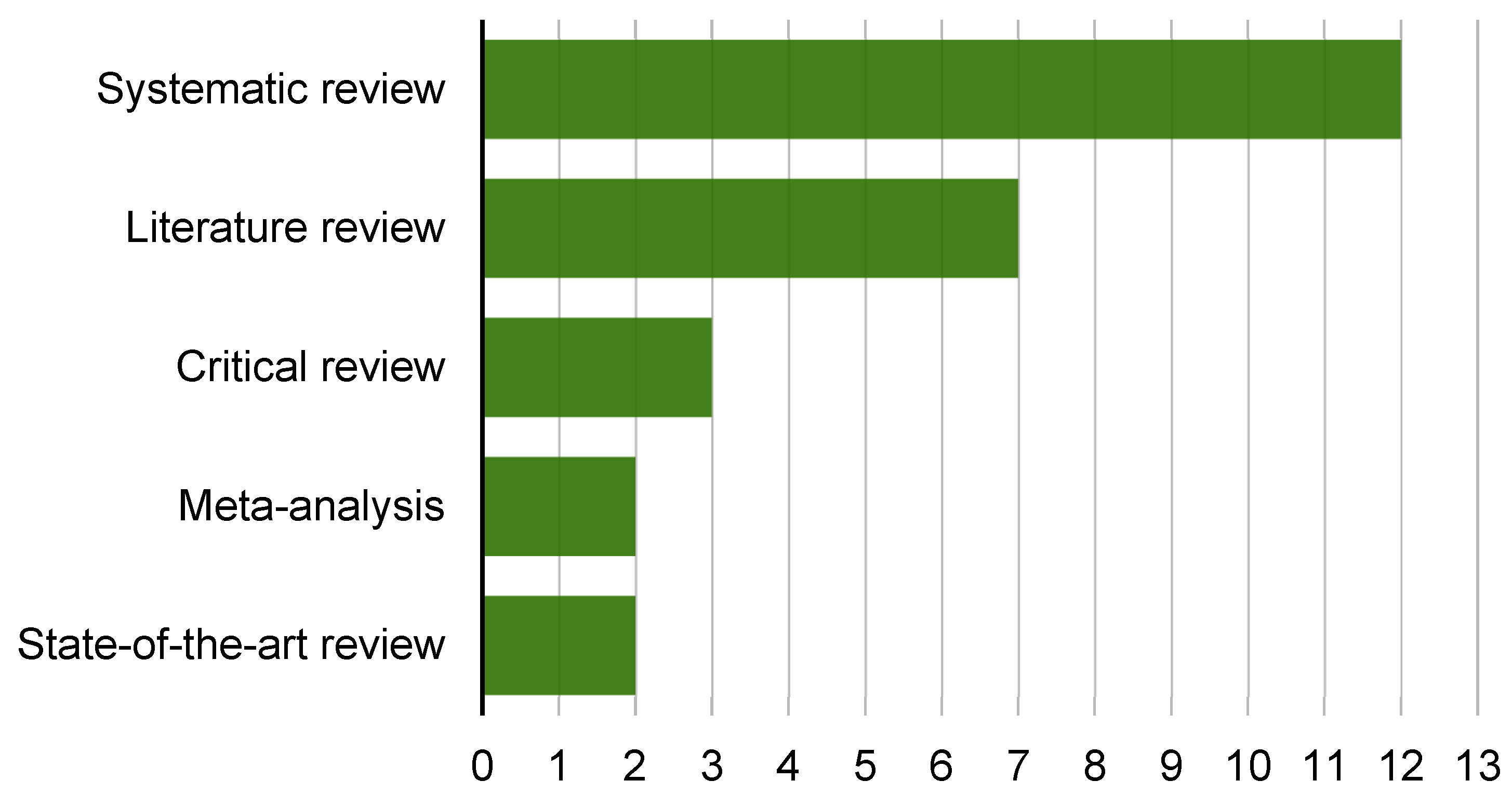
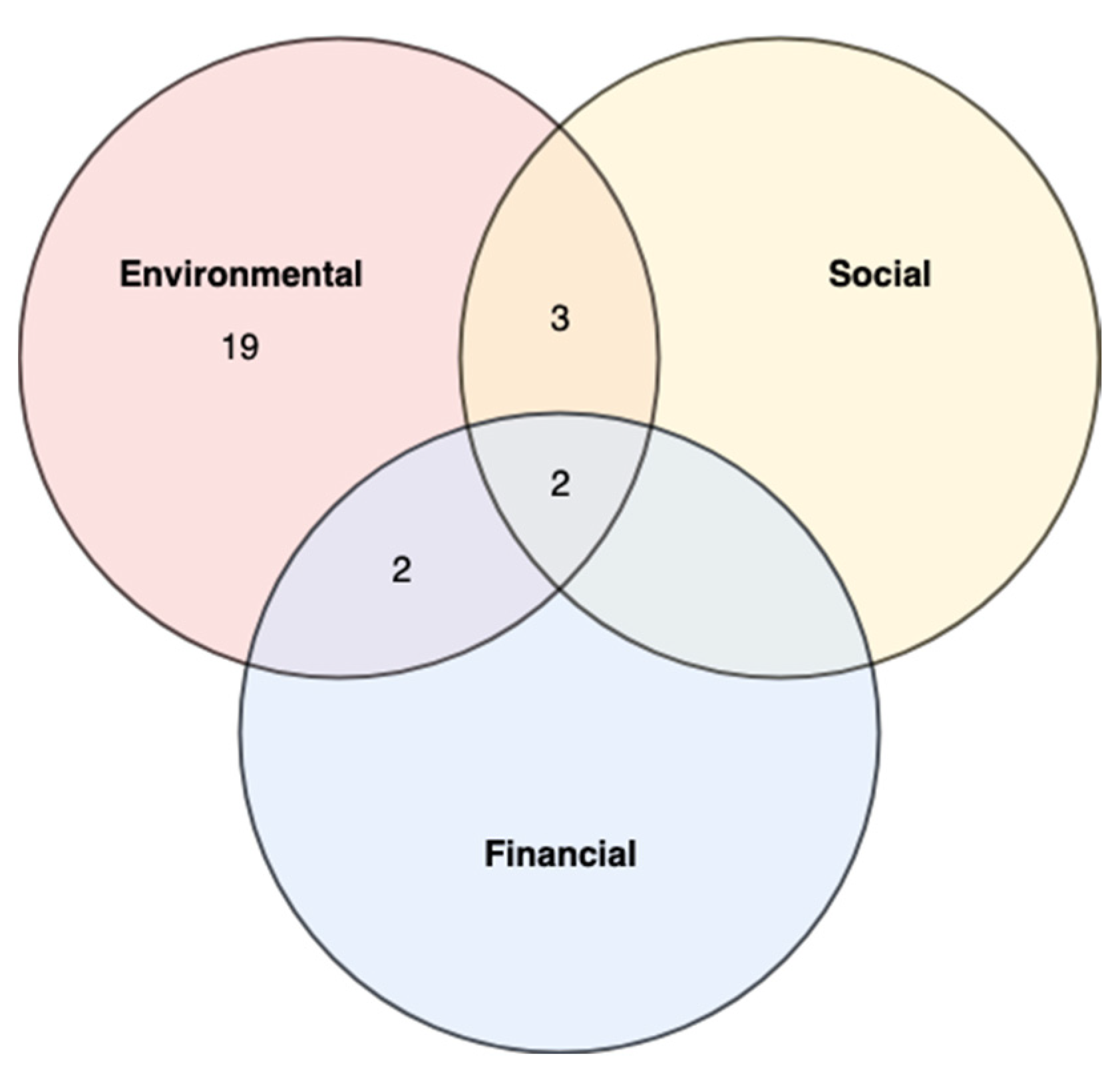
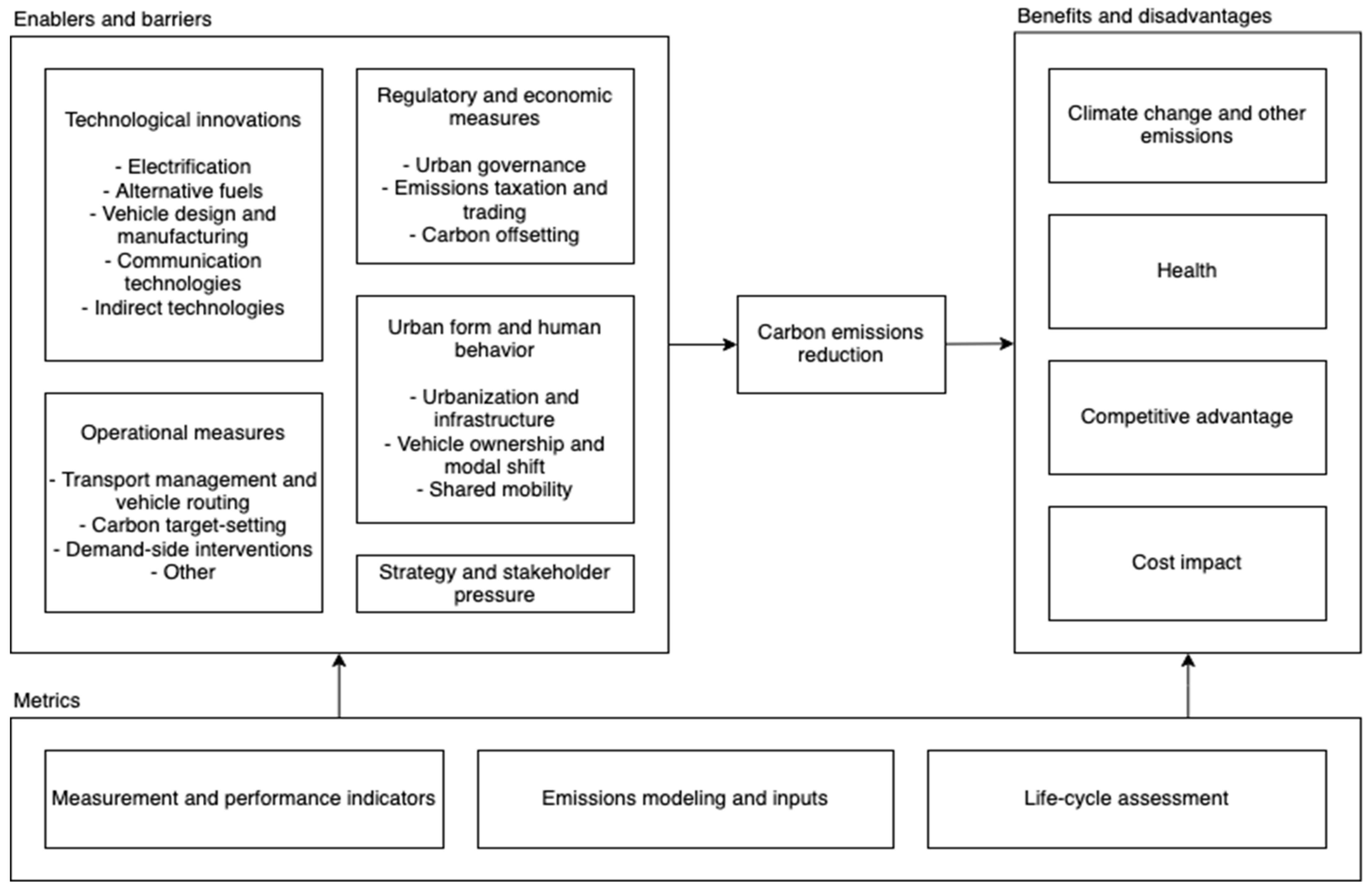
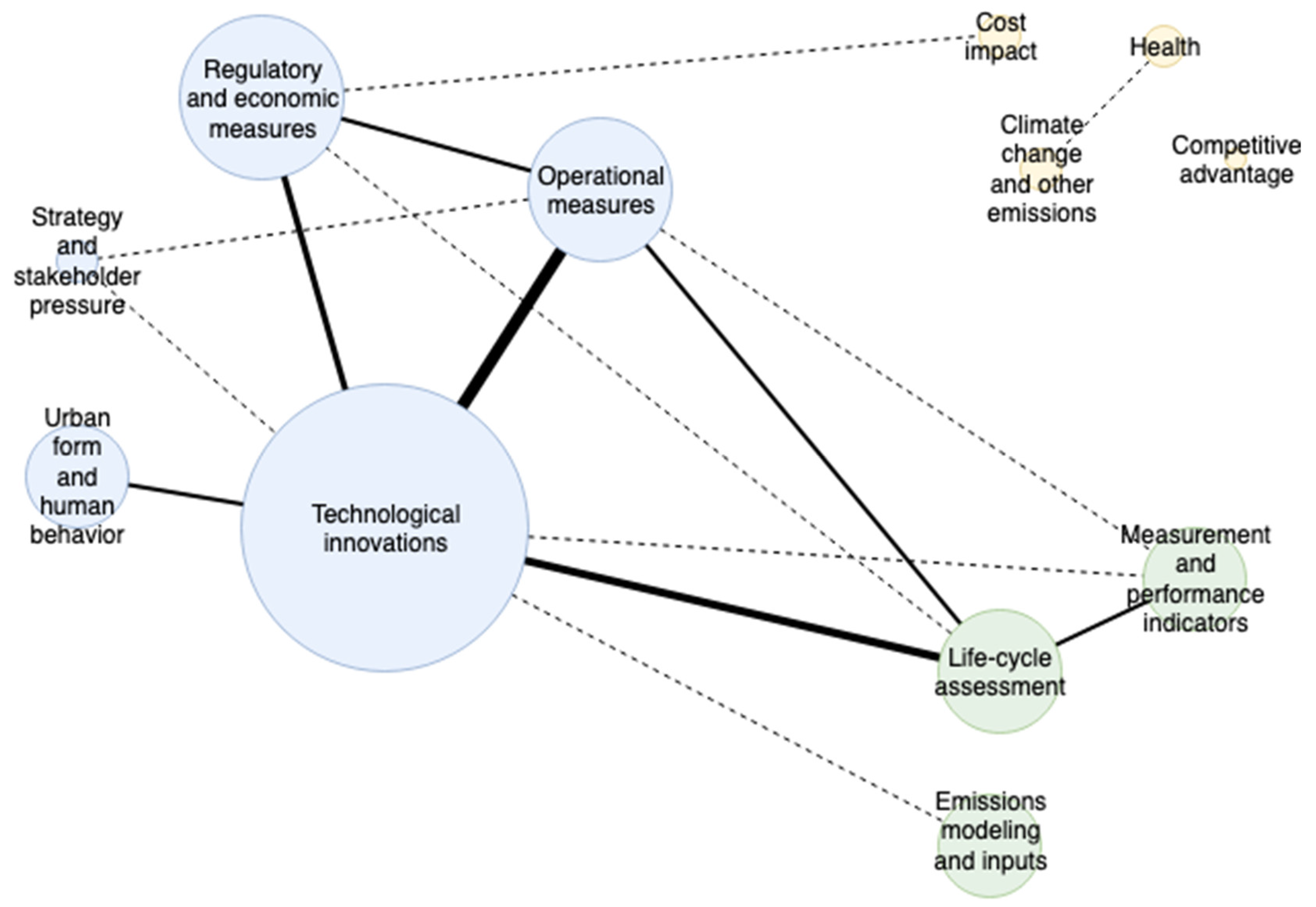
| Search Keywords and Restrictions | No. of Papers Included | |
|---|---|---|
| Scopus | WoS | |
| (“transport*” OR “ship*”) AND (“metric*” OR “measur*” OR “quanti*”) AND (“green” OR “sustainab*” OR “environment*”) AND (“climate change” OR “carbon” OR “CO2” OR “greenhouse effect”) | 16,437 | 11,375 |
| Restricted to articles and reviews | 13,458 | 10,420 |
| English language only | 12,949 | 10,315 |
| Total selected from the topic area: | 23,264 | |
| Total selected from the topic area (without duplicates): | 16,635 | |
| (“research synthesis” OR “systematic review” OR “evidence synthesis” OR “research review” OR “literature review” OR “meta-analysis” OR “meta-synthesis” OR “mixed-method synthesis” OR “narrative reviews” OR “realist synthesis” OR “meta-ethnography” OR “state-of-the-art” OR “rapid review” OR “critical review” OR “expert review” OR “conceptual review” OR “review of studies” OR “structured review” OR “systematic literature review” OR “literature analysis” OR “in-depth-survey” OR “literature survey” OR “analysis of research” OR “empirical body of knowledge” OR “overview of existing research” OR “body of published knowledge” OR “review of literature”) | 321 | 244 |
| Total selected for the tertiary research: | 565 | |
| Total selected for the tertiary research (without duplicates): | 411 | |
Disclaimer/Publisher’s Note: The statements, opinions and data contained in all publications are solely those of the individual author(s) and contributor(s) and not of MDPI and/or the editor(s). MDPI and/or the editor(s) disclaim responsibility for any injury to people or property resulting from any ideas, methods, instructions or products referred to in the content. |
© 2023 by the authors. Licensee MDPI, Basel, Switzerland. This article is an open access article distributed under the terms and conditions of the Creative Commons Attribution (CC BY) license (https://creativecommons.org/licenses/by/4.0/).
Share and Cite
Ferrer, A.L.C.; Thomé, A.M.T. Carbon Emissions in Transportation: A Synthesis Framework. Sustainability 2023, 15, 8475. https://doi.org/10.3390/su15118475
Ferrer ALC, Thomé AMT. Carbon Emissions in Transportation: A Synthesis Framework. Sustainability. 2023; 15(11):8475. https://doi.org/10.3390/su15118475
Chicago/Turabian StyleFerrer, Ana Luiza Carvalho, and Antonio Márcio Tavares Thomé. 2023. "Carbon Emissions in Transportation: A Synthesis Framework" Sustainability 15, no. 11: 8475. https://doi.org/10.3390/su15118475
APA StyleFerrer, A. L. C., & Thomé, A. M. T. (2023). Carbon Emissions in Transportation: A Synthesis Framework. Sustainability, 15(11), 8475. https://doi.org/10.3390/su15118475








